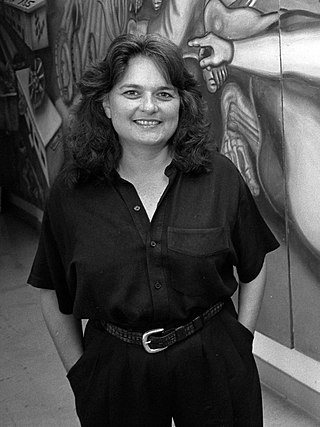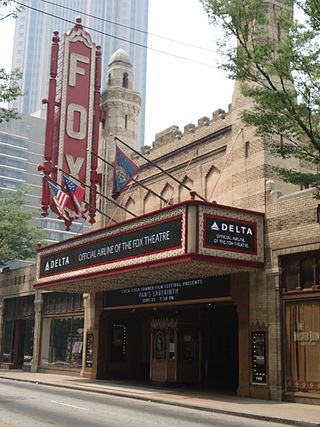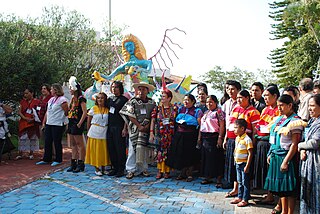
Graffiti is writing or drawings made on a wall or other surface, usually without permission and within public view. Graffiti ranges from simple written "monikers" to elaborate wall paintings, and has existed since ancient times, with examples dating back to ancient Egypt, ancient Greece, and the Roman Empire.

A mural is any piece of graphic artwork that is painted or applied directly to a wall, ceiling or other permanent substrate. Mural techniques include fresco, mosaic, graffiti and marouflage.

Street art is visual art created in public locations for public visibility. It has been associated with the terms "independent art", "post-graffiti", "neo-graffiti" and guerrilla art.

Chicano Park is a 7.9 acres (32,000 m2) park located beneath the San Diego–Coronado Bridge in Barrio Logan, a predominantly Chicano or Mexican American and Mexican-migrant community in central San Diego, California. The park is home to the country's largest collection of outdoor murals, as well as various sculptures, earthworks, and an architectural piece dedicated to the cultural heritage of the community.

The Freedom Tunnel is a railroad tunnel carrying the West Side Line under Riverside Park in Manhattan, New York City. Used by Amtrak trains to and from Pennsylvania Station, it got its name because the graffiti artist Chris "Freedom" Pape used the tunnel walls to create some of his most notable artwork. The name may also be a reference to the former shantytowns built within the tunnel by homeless populations seeking shelter and freedom to live rent-free and unsupervised by law enforcement. The tunnel runs approximately 2.6 miles (4.2 km), from 72nd Street to 124th Street.

Judith Francisca Baca is an American artist, activist, and professor of Chicano studies, world arts, and cultures based at the University of California, Los Angeles. She is the co-founder and artistic director of the Social and Public Art Resource Center (SPARC) in Venice, California. Baca is the director of the mural project that created the Great Wall of Los Angeles, which was the largest known communal mural project in the world as of 2018.

Since the 1980s, the area surrounding the Sydney inner west suburb of Newtown, Australia, including the suburbs of Newtown, Enmore, Erskineville, Camperdown and St Peters, has been known for its wide range of prominent graffiti and street art on walls. The public visual art in the Newtown area consists of a variety of styles and methods of execution, including large-scale painted murals, hand-painted political slogans, hand-painted figurative designs, spray painted semi-abstract designs "tags"), and other stylistic developments such as stencil art and street poster art, "Yarn bombing", and sculptural items cast from plaster and other materials.

The Festival Internacional Cervantino (FIC), popularly known as El Cervantino, is a festival which takes place each fall in the city of Guanajuato, located in central Mexico. The festival originates from the mid 20th century, when short plays by Miguel de Cervantes called entremeses were performed in the city's plazas.

Melbourne, the capital of Victoria and the second largest city in Australia, has gained international acclaim for its diverse range of street art and associated subcultures. Throughout the 1970s and 1980s, much of the city's disaffected youth were influenced by the graffiti of New York City, which subsequently became popular in Melbourne's inner suburbs, and along suburban railway and tram lines.

Sarasota Chalk Festival is an American cultural event of public art that celebrates a performing art form of pavement art also known as Italian street painting. It was founded in Sarasota, Florida by Denise Kowal. During the festival artists use chalk, and occasionally special paint, to paint the road surface to create large works of art while the viewer can watch the creative process. The festival is focused around the street artists who are known as Madonnari in Italy or commonly referred to Street Painters, Chalk Artists, Sidewalk Artists, or Pavement Artists. The festival is held annually in downtown Sarasota in Burns Square.

Graffiti in Iran consists of different styles. Some are slogans painted by governmental organizations, and some are works of art by regular citizens. During the last few years, Tehran Municipality has been drawing graffiti in order to beautify the city. Much governmental graffiti regards the Iranian Revolution, Islamic Republic of Iran policies and The Politics of Resistance. Pro-democracy activists are also continuing a political graffiti campaign in Tehran. Islamic graffiti can also be seen around the city. Graffiti has long served as a medium of expression through Iran's complicated political history.

Graffiti in Toronto, Ontario, Canada, is a cause of much disagreement among its residents. Graffiti is seen by some as an art form adding to the Toronto culture; however, others see graffiti as form of vandalism, viewing it as ugly, or as a form of property damage.

The Chicano Art Movement represents groundbreaking movements by Mexican-American artists to establish a unique artistic identity in the United States. Much of the art and the artists creating Chicano Art were heavily influenced by Chicano Movement which began in the 1960s.

The arts in Atlanta are well-represented, with a prominent presence in music, fine art, and theater.
In recent years, Atlanta has been called one of the USA's best cities for street art. Street artists have prominently created murals in Krog Street Tunnel, along the BeltLine, and in neighborhoods across the city. The street art conference, Living Walls, the City Speaks, originated in Atlanta in 2009.
Alex Brewer, also known as HENSE, is an American contemporary artist, best known for his dynamic, vivid and colorful abstract paintings and monumental wall pieces. He has been active since the 1990s. In 2002 he began accepting commissions for artwork and over the course of the last decade has established a solid reputation as a commissioned artist, having appeared in several solo and group shows.

Feria Maestros del Arte is a non profit organization and annual three-day event held to support Mexican handcrafts and folk art in Chapala, Jalisco, Mexico. Unlike other fairs of this type, invited participants are not charged booth fees or percentages, and are even afforded transport and accommodations with area families. The Feria has grown from thirteen artisan participants to over eighty, and the organization is legally recognized in Mexico and the United States.
Facter, or Fletcher Anderson, is a Melbourne based, Australian multi-disciplinary artist, best known for his colorful creatures rendered in a illustrative style.

Paint Louis is an annual global community event happening over the American holiday Labor Day bringing together people practicing all four elements of hip hop including graffiti, breakdancing, rapping and DJs to St. Louis for three days of creation and performance. The event started informally in 1995 as a "graffiti jam" and became more formalized in 1997 as noted with its 20th anniversary celebration in 2017. For the 25th year of the annual event, Paint Louis brought hip-hop pioneer KRS-One to perform at the event for free.

Street art in Israel refers to different forms of visual art found on public walls, buildings, and other surfaces throughout the State of Israel. Israeli street art reflects the country's unique cultural, historical, and political landscape.


















